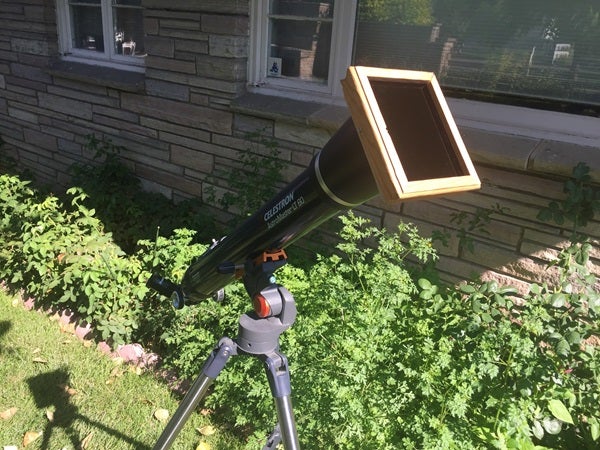To the amateur astronomers out there — I know, I know. A 60mm telescope isn’t exactly an impressive rig. I would never have purchased such a borderline toy telescope, but that wouldn’t prevent me from taking one if I just stumbled across it. And a few weeks before the eclipse, this exact thing happened. On trash day in the college town I live in with my academic partner, this Celestron called to me while I was walking the dog and, low power or not, it deserved better than the garbage dump.
Plus, you know, it was $FREE.99.
I had used it once to observe the Moon. It did … ok, but everything was in functional order. I figured I could clean it up and hock it on Craigslist or Facebook for some beer money. As we rushed out the door, it was the only telescope ready to go, and I reasoned that if we built a homebrew filter, it had the best chance of being the right size.
As it ended up, it was absolutely perfect.
My dad is a sort of amateur engineer, a retired power plant safety guy who seemingly knows everything about home and car repair. We talked about using welding glass, but NASA’s recommendation was at least #14 welder’s glass, and he only had #9 or below, and only in two-inch-wide variations.
We headed to Troyer Enterprises in North Platte to see if they had any. Eclipse observers had picked them dry of anything but 8’s. We left, brewing up ideas. Then I hit on an online thread on Stack Exchange that suggested that you could stack welder’s glass. The math presented was a bit complicated, but basically boiled down to protection number + protection number – 1. Two 8’s would add to 16. Subtract 1, and you have #15 protection.
(I later confirmed with an expert that you can indeed stack welder’s glass numbers, though he warned that it’s not really the recommended way to get the best image.)
We bought two for a grand total of $6. The telescope rig needed a few new bolts owing to its trashy heritage, adding up to around $1 more. We were really breaking the bank here.
At four inches by five inches, there was a lot of extra room length-wise in the glass, and we didn’t have a glass cutter. So we’d have to make do with some overhang. Then there was the matter of attaching it to the telescope. The aperture is round. The glass is rectangular. We needed to hold it in place somehow.
We used picture frame molding to build a nice wooden frame around the glass, then stacked the glass inside. A few pieces of wood behind that to hold the glass in place, and we had a pretty good solar filter, all from wood scraps my dad had hiding in his workshop. A few small screws secured it in place.
The night before eclipse day, the weather in Nebraska was looking not-great. So my partner and I drove through the night, borrowing my parent’s roomy Chevy Equinox instead of our much-smaller Prius to head to Glendale, Wyoming, where we found a last minute camping spot. She hoped to meet up with her undergraduate advisor, astrophysicist Laura Kay, and I hoped to meet up with Ernie Mastroianni, Discover magazine’s photo editor, at Glendo State Park the next day.
We grumpy travelers decided that instead of arguing while putting up a tent in the late night hours that we’d just fold down the back seats and make a makeshift bed, our small dog finding a place to sleep in the wheel well. We slept, got up early … and found ourselves unable to get into Glendo State Park due to the famous Wyoming traffic jam. So we headed back to our pasture-land camping site.
From there, eclipse day went off without a hitch, and the solar filter worked beautifully. Of course, we received taunting text messages from my family that the weather in Nebraska had actually cleared up. We kept track of the movements of the Moon through the telescope, and waited for our few sweet minutes of totality.
John Wenz
I got a tremendous view of the eclipse, all thanks to an amateur engineer father and a trashpicked telescope, and I did it for less than $10. Our eclipse viewing was exceptional.
The Wyoming traffic afterward was not. Nor the stomach flu we got that night. But that’s a story for another time and another publication.










